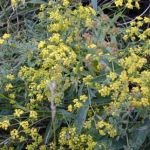| Common Name: |
Sickle-leaved Hare's Ear |
| Botanical Name: |
Bupleurum falcatum syn. B. scorzoneraefolium, B. chinense |
| Genus: |
Bupleurum |
| Family: |
Apiaceae |
| Native Location: |
S, C, and E Europe, Asia |
| Cultivation: |
Well-drained soil in full sun. |
| Propagation: |
By seed sown in spring; by division in spring. |
| Harvest: |
Roots are lifted in autumn and used fresh, or dried for decoctions. |
| Height: |
30cm-1m (1-3ft) |
| :Width |
30-60cm (12-24in) |
| Hardiness: |
Z4-9 |
| Parts Used: |
Rooths (chai hu) |
| Properties: |
A bitter herb that acts as a tonic for the liver and circulatory system, lowers fevers, and has anti-inflammatory and anti-viral effects. |
| Medicinal Uses: |
Internally for blackwater fever, malaria, uterine and rectal prolapse, herpes simplex, hemmorhoids, sluggish liver associated with emotional instability, menstrual disorders, dizziness, and abdominal bloating. Often used raw with wine for feverish illnesses, with vinegar as a circulatory stimulant, with Glycyrrhiza spp. (see licorice) to improve liver function, or mixed with tortoise blood for malaria. |
| Bibliography: |
Encylopedia of Herbs by Deni Brown Copyright ©: 1995, 2001 Dorling Kindersley Limited pg 148
|

